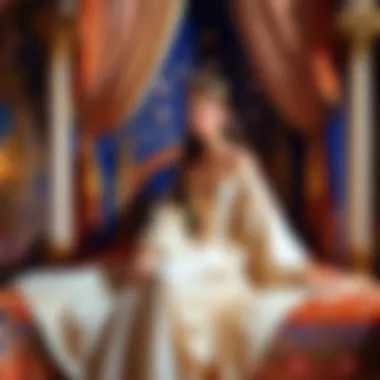Exploring the Depths of Sleepy Princess in Demon Castle


Intro
The world of anime and manga often interweaves intricate narratives with rich themes and diverse characters. Within this landscape, Sleepy Princess in the Demon Castle presents a unique tale. It is an exploration of character development, cultural symbolism, and artistic expression set against a backdrop that intrigues audiences. This article embarks on a comprehensive analysis, striving to uncover the depths of this story's essence, its character arcs, and its implications within the broader canon of Japanese animation.
Series Overview
Synopsis and Premise
At its core, Sleepy Princess in the Demon Castle unveils the adventures of a princess who finds herself in the unconventional predicament of being captured by demons. Contrary to the typical dynamic of captivity, this narrative takes a refreshing stance by showcasing the princess's unwavering desire for her beauty sleep. This interesting premise serves as the gateway into a world where the conventions of heroism and villainy blur, allowing for a deeper exploration of the characters' motivations and desires.
Notable Characters
The focal point of this narrative is, without a doubt, the Sleepy Princess herself. Her character is crafted with layers of complexity, challenging traditional notions of femininity and helplessness. Rather than waiting for rescue, she manipulates her surroundings with a mix of charm, wit, and an unwavering need for slumber.
In addition to the princess, the other characters, including various demons guarding the castle, play crucial roles in shaping the dynamics of the storyline. Each demon presents a unique perspective on captivity and freedom, which enhances the overall thematic depth of the series.
Themes and Motifs
Major Themes Explored
The overarching theme of Sleepy Princess in the Demon Castle revolves around autonomy versus control. The princess's struggle for her personal space amid her captors highlights her innate desire for independence. Furthermore, themes of identity and transformation permeate the story, as characters navigate their roles in a world that seems determined to define them.
Symbolism in Storytelling
Symbolism is prevalent throughout the series. The demon castle itself serves as a representation of confinement and societal expectations. It stands in stark contrast to the princess's inner world, where dreams and aspirations reside. Through various interactions and conflicts, the show subtly invites viewers to reflect on their definitions of freedom and captivity.
Artistic Style and Animation
Visual Aesthetics and Design
Artistically, Sleepy Princess in the Demon Castle employs a distinctive aesthetic that combines whimsy with detailed craftsmanship. The character designs are playful yet strikingly expressive, reflecting their personalities in a way that captivates the audience. Color palettes fluctuate between vibrant hues and muted tones, emphasizing the emotional landscape throughout the narrative.
Animation Techniques and Trends
The animation of this series showcases a blend of traditional and digital techniques, which adds fluidity to action sequences while retaining a sense of charm during quieter moments. This dynamic allows it to remain engaging and visually appealing, demonstrating an understanding of current trends in animation while paying homage to established practices.
The narrative effectively reflects cultural expectations while presenting an alternative perspective on traditional roles within fantasy settings.
In summary, Sleepy Princess in the Demon Castle offers a rich tapestry of insights into character development, thematic richness, and artistic excellence. Exploring each aspect meticulously reveals the depth of this narrative, affirming its place in the annals of anime history. Understanding such works enhances appreciation for the artistry and ingenuity present in anime and manga culture.
Prologue to the Story
Understanding the narrative of The Sleepy Princess in Demon Castle serves as a critical gateway into the world crafted by its creators. This story offers not only unique characters and engaging plotlines but also reflects cultural nuances inherent to Japanese folklore and storytelling traditions. For anime and manga enthusiasts, delving into this tale is essential for comprehending its broader implications within the genre.
Overview of the Plot
The central plot revolves around a princess who is perpetually sleepy, creating a juxtaposition between her benign persona and the ominous setting of a demon's castle. At first glance, the narrative may appear simplistic, yet its layers unveil complex themes of identity, power dynamics, and personal agency.
The princess, as the central figure, is captured by the demon king, a being whose traditional role as an antagonist is shifted in this context. As the story progresses, her character emerges from a passive state to one of resilience and discovery, leading to unexpected alliances and confrontations. Key events are interspersed with moments of levity, which provide insight into the princess's psyche and her interactions with the castle's inhabitants.
"The unique structure allows the protagonist to navigate her circumstances not as a victim, but as an active participant in her fate."
This shift in character dynamics propels the narrative, making it crucial to analyze how plot elements contribute to character development and thematic exploration.


Setting and Atmosphere
The setting of the demon castle plays a pivotal role in shaping the narrative. It is not merely a backdrop but an entity that influences the dynamics among characters. Dark and foreboding, the castle reflects the internal struggles of the characters, especially that of the sleepy princess.
Through detailed artwork and consistent world-building, the atmosphere evokes a sense of tension and mystery, enhancing the viewing experience for the audience. The interplay of light and shadow sets the tone, making each scene impactful. Although the castle is filled with dark creatures and towering structures, there are also moments of beauty, representing the duality of the princess’s experience — being trapped yet finding pockets of wonder amidst the chaos.
The contrasting elements blend traditional themes with modern storytelling techniques, which is hallmark in the genre. The atmosphere, therefore, not only envelops but also facilitates the themes of power and vulnerability that play out across the narrative.
Character Analysis
Character analysis plays a crucial role in understanding the depth of the narrative within The Sleepy Princess in Demon Castle. It enables us to explore the motivations, transformations, and relationships of characters in this story. By focusing on character development, we can gain insight into their complexity and the thematic elements they represent. This section dives deep into the main characters, dissecting their attributes and significance, eliciting a richer comprehension of the overall narrative.
The Sleepy Princess: A Central Figure
The Sleepy Princess stands at the heart of this tale. Her character is not just about her unique state of slumber; it illustrates a deeper commentary on perception and identity. She is often viewed as passive but demonstrates resilience and introspection as the story unfolds.
In the beginning, the princess is somewhat of an enigma. Her sleep reflects a disconnect from her surroundings. From her responses, or sometimes lack thereof, we see hints of her intelligence and emotional depth. As she navigates the challenges within the demon castle, her character evolves significantly. This evolution becomes a lens through which we can examine her self-discovery.
Key Points:
- Highlights her importance in driving the narrative.
- Illustrates her complexities and inner thoughts.
- Develops themes of autonomy and identity.
The Demon King: Catalyst of Change
The Demon King plays a vital role as a catalyst in the story. While he appears intimidating, a closer examination reveals layers to his character. The king represents both the obstacle and the opportunity for the princess's growth. His interactions with her expose the dynamics of power and vulnerability.
As the narrative progresses, we witness his transformations, shaped by the princess's presence. His motivations are not merely villainous; they evoke sympathy and complexity. The king's character reinforces the theme of opposites, showcasing how two disparate figures can influence each other's journeys.
Key Points:
- Serves as a pivotal force in the princess's development.
- Symbolizes the potential for change amidst conflict.
- Embodies complexities of authority and sympathy.
Supporting Characters and Their Roles
Supporting characters in The Sleepy Princess in Demon Castle further enrich the narrative landscape. Each character contributes uniquely to the progression of the plot and the central themes. For instance, the knights who guard her offer comic relief but also serve to highlight her loneliness. Their diverse personalities and interactions with the princess allow for various perspectives on her situation.
Other characters, such as the castle's inhabitants, provide additional context for the setting and enhance the thematic undertones of the story. They reflect societal norms and challenge the expectations pinned on the princess and the Demon King. Their presence amplifies the narrative's exploration of relationships and the intricacies of hierarchy.
Key Points:
- Provide diverse perspectives on the central themes.
- Reflect societal norms and expectations.
- Enhance the emotional depth of the narrative.
Understanding character analysis in The Sleepy Princess in Demon Castle not only enriches our knowledge of individual figures, but also allows us to appreciate the interconnectedness of their journeys.
Themes Explored
The themes explored in The Sleepy Princess in Demon Castle are pivotal to its narrative strength and depth. They offer layers of understanding to the characters and their situations, enhancing the overall storytelling. By dissecting these themes, readers can grasp the comprehensive arc of the plot and the emotional journeys of the characters involved. The themes, such as identity, power dynamics, vulnerability, love, and sacrifice are intertwined and contribute to the essence of the tale. Each one invites readers to evaluate not just the fictional world but also reflect on their lives and values.
Identity and Self-Discovery
The theme of identity and self-discovery is crucial in this narrative. The Sleepy Princess is not merely a damsel in distress; her character goes through a process of awakening, both literally and metaphorically. As she navigates the challenges posed by her surroundings, she begins to understand her own desires, strengths, and limitations.
Her journey reflects the nuances of self-identity in a complex world. The princess’s constant struggle against her external constraints symbolizes many individuals' paths toward self-realization. In the context of anime culture, this theme resonates deeply, encouraging viewers to think about their identity beyond societal expectations. As she learns to assert herself, her journey prompts a discussion on the importance of recognizing personal worth and strength.


Power and Vulnerability
Power dynamics play a significant role in this tale. The Demon King, initially portrayed as powerful and intimidating, ends up revealing layers of vulnerability. The contrast between the princess's seemingly helpless state and the king's authority challenges traditional notions of strength and control.
This theme explores how power can often mask insecurities and vulnerabilities. The princess's attitude, despite her title, represents a different kind of strength. She exudes a calm resilience, which makes her not just a passive character. Through her interactions with the Demon King and other characters, the narrative emphasizes that vulnerability can coexist with power. This duality encourages viewers to rethink their assumptions about strength and submission in relationships.
Love and Sacrifice
The theme of love and sacrifice emerges as one of the story's most poignant aspects. The relationship between the Sleepy Princess and the Demon King evolves in a manner that challenges preconceived notions.
- Love as a Driving Force: Their connection, rooted in unexpected circumstances, forces both characters to reconsider their priorities and values.
- The Nature of Sacrifice: Throughout the narrative, both the princess and the king are faced with choices that require great personal sacrifice. This underlines the notion that true love often demands difficult choices.
This theme reflects the complexities of relationships, suggesting that love is not just about joy and companionship, but also about navigating forces that might want to tear individuals apart. The sacrifices made redefine what both characters are willing to endure for each other, showcasing how love can ultimately become a transformative power.
The themes present in The Sleepy Princess in Demon Castle provoke thought, challenging the audience to engage with their implications beyond the screen. As characters face their trials, so do viewers confront the truths within their own lives.
Narrative Structure
Understanding the narrative structure of a story is crucial in appreciating its depth and emotional impact. The tale of the Sleepy Princess in the Demon Castle is no exception. It employs a carefully crafted narrative that drives the plot forward while enriching the characters' development. This structure allows for a harmonious blend of conflict and resolution, drawing the audience into the princess's journey and her interactions within the demon castle.
The significance of narrative structure lies in its ability to shape the emotional arcs and tensions present in the story. It consists of various elements, including exposition, rising action, climax, falling action, and resolution. In the Sleepy Princess, these elements come together to create a seamless experience that captivates the viewers.
Plot Development Techniques
In this narrative, the development of the plot relies heavily on strategic pacing and moments of tension. The exposition introduces us to the princess and her peculiar situation. As she navigates through the demon castle, the pacing allows for gradual revelations about her character and her environment. Key techniques in plot development include:
- Foreshadowing: Subtle hints throughout the story build anticipation for future events.
- Conflict Introduction: The challenges the princess faces within the castle escalate, keeping the audience engaged.
- Twists and Turns: Unexpected developments maintain the narrative's unpredictability,
Together, these techniques ensure that the plot remains engaging, even as it explores deep themes.
Character Arc Progression
The progression of characters is another vital component of the narrative structure. The Sleepy Princess does not remain static; instead, she evolves through her experiences. Her arc illustrates the transition from being a passive figure to actively engaging with her surroundings.
- Initial State: At the beginning of the story, the princess is largely indifferent to her fate, highlighting her initial vulnerability.
- Catalyst Events: Encounters with the Demon King and other characters force her to reevaluate her position. Each interaction fosters growth and self-awareness.
- Resolution: By the end of the narrative, she emerges as a more resolute individual, demonstrating enhanced agency.
By meticulously constructing her character arc, the narrative illustrates a compelling journey of self-discovery, resonating deeply with the audience.
Artistic Elements
Artistic elements play a crucial role in shaping the narrative and thematic depth of any story, particularly in visual media such as anime and manga. In the context of the 'Sleepy Princess in Demon Castle', these elements are not mere components but form the backbone of storytelling. Analyzing these aspects provides insight into the creator's intent and the emotional impact on the audience.
Visual Style and Impact
The visual style of 'Sleepy Princess in Demon Castle' serves as a gateway to its rich narrative. The art combines whimsical character design with a vibrant color palette. This choice of style is essential; it lures viewers into a fantastical world that feels alive and engaging.
Every episode showcases detailed backgrounds that enhance the oppressive yet strangely inviting atmosphere of the demon castle. The contrast between the princess's serene demeanor and the chaotic environment around her creates a unique tension that captures the audience’s attention.
Furthermore, character expressions are skillfully crafted, allowing viewers to experience emotional shifts without the necessity of extensive exposition. This visual storytelling complements the narrative, making it accessible even to those who may not be fluent in Japanese storytelling forms.
Through Attention to details, such as shadows and light, the visual elements deepen the audience's immersion. They feel the weight of the princess's sleepy journeys.
Symbolism in Artwork


Symbols are abundant in the artwork of 'Sleepy Princess in Demon Castle'. They carry deeper meaning beyond the obvious, contributing layers to the story. For example, the castle itself symbolizes confinement and security but also represents complexity and danger. It embodies the duality of the princess's experience.
Additionally, the recurring motif of sleep can be seen as a metaphor for escapism and the desire to retreat from one’s reality. It raises questions about the nature of power and passivity. This symbolism encourages audiences to reflect on how these themes are relevant to life, prompting a deeper connection between viewers and the story.
"Art is the most beautiful of all lies." - Pablo Picasso
Cultural Context
The cultural context surrounding The Sleepy Princess in Demon Castle is essential for understanding its narrative depth and significance. This work is not only a product of artistic creativity but also a reflection of cultural values and historical perspectives found in Japanese society. Examining the cultural context reveals motivations behind character designs, plot developments, and thematic elements, enriching the overall discourse on this tale.
Influences from Japanese Folklore
The narrative draws heavily from Japanese folklore, which is replete with tales of supernatural beings and their encounters with humans. Folklore serves as a foundation for many elements in anime and manga, including archetypes and plot structures. The way the Sleepy Princess interacts with the demons in the castle can be seen as an echo of classical Japanese myths where humans engage with spirits, often learning profound lessons about life and existence.
- Traditional folklore presents various supernatural creatures.
- The character of the Demon King is reminiscent of these creatures, encapsulating both fear and allure.
- The princess’s sleepy nature aligns with themes of fate found in folklore, often suggesting a deeper understanding of one's self and purpose.
In many ways, these influences create a narrative that is both familiar yet uniquely innovatve. They provide layers to the story, making it resonate with viewers who recognize these elements as part of their cultural identity.
Historical Perspectives on Heroine Archetypes
In analyzing the story through the lens of historical perspectives, the archetype of the heroine is notably significant. The Sleepy Princess represents more than just a passive character. Historically, female characters in Japanese media have displayed a range of agency and vulnerability. The narrative challenges the stereotypical perception of a damsel in distress.
- Empowerment: Unlike traditional heroines who are often mere objects of rescue, the princess makes choices that affect her fate.
- Complexity: Her character is multilayered, navigating between strength and vulnerability, showcasing a modern take on the heroine archetype.
- Evolution: The portrayal of women in Japanese media has evolved. The princess embodies this shift, aligning with contemporary values that celebrate female empowerment.
"The journey of the Sleepy Princess reflects the evolving nature of female representation in anime, embracing complexity and depth."
In essence, the cultural context enriches the narrative of The Sleepy Princess in Demon Castle. By examining influences from Japanese folklore and the historical perspectives on heroine archetypes, readers can appreciate the intricacies of the story and its characters. These elements not only define the narrative but also highlight its importance in the broader framework of anime culture.
Impact on the Anime and Manga Community
The story of the Sleepy Princess in Demon Castle resonates deeply within the anime and manga community. Its unique narrative explores themes not commonly seen, such as the juxtaposition of vulnerability and strength. This is an essential aspect that enhances its relevance in conversations about modern storytelling in Japanese animation.
Reception and Critique
The reception of Sleepy Princess in Demon Castle has been largely positive, marking it as a standout within its genre. Critics have highlighted the refreshing take on traditional tropes. Many reviews commend the characterization of the Sleepy Princess, noting her depth and relatability.
Moreover, the humor interwoven with moments of genuine character introspection creates a compelling contrast. Viewers appreciate how these elements lead to engaging discussions. Social media platforms, such as Reddit, have active threads dissecting episodes, showcasing the series' impact on anime enthusiasts.
"The blend of lighthearted comedy and serious themes is a strength of Sleepy Princess in Demon Castle. It makes the characters feel real."
Legacy and Influence on Modern Works
The influence of Sleepy Princess in Demon Castle extends beyond immediate fan reception. This series has inspired other creators, encouraging them to explore complex characters and layered narratives. Some works recently adopted a similar structure, emphasizing slow-burn storytelling.
It also set a standard for how female protagonists can be portrayed. Rather than conforming to typical archetypes, the Sleepy Princess exhibits vulnerability while also being strong in her own quiet way.
Creators can draw from this legacy, fostering a more diverse array of characters in upcoming projects. The impact is evident in how discussions about character development have changed in the anime community.
The narrative encourages a reevaluation of traditional roles, leading to broader representation and deeper plots. As the anime and manga community evolves, the contributions of this series remain vital to that progress.
Culmination
The concluding section of this article provides a pivotal opportunity to reflect on the intricate layers that compose the narrative of the Sleepy Princess in the Demon Castle. In encompassing the analysis of character development, thematic depth, and cultural significance, this final thoughts segment synthesizes the insights derived throughout the discourse.
Final Thoughts on the Narrative
In examining the journey of the Sleepy Princess, significant elements come into focus. The complexities of her character arc reveal a nuanced portrayal of vulnerability, strength, and self-discovery. This narrative structure not only engages the audience but also compels a deeper contemplation of identity within the confines of societal expectations and cultural narratives.
The narrative weaves a rich tapestry that explores the themes of love and sacrifice, inviting viewers to reflect on their understandings of these universal concepts. The relationship between the princess and the Demon King serves as a catalyst for transformation, emphasizing the dichotomy of power and vulnerability. Such dynamics are integral to the character's evolution, illustrating that true strength often lies in embracing one’s weaknesses.
Moreover, the cultural context provides an additional layer of significance. The tale resonates within the larger framework of Japanese folklore, drawing parallels with historical archetypes of heroines. This alignment enhances the narrative's relatability, enabling audiences to connect with the characters on a more profound level.
"The essence of the Sleepy Princess's story lies not merely in its fantasy elements, but in its exploration of profound human experiences."
As this exploration concludes, it emphasizes the importance of appreciating the narrative's depth and its impact on the anime and manga community. The legacy left by the Sleepy Princess reaches beyond mere entertainment. Instead, it cultivates a modern dialogue on themes crucial to personal identity and emotional resilience, lasting in the hearts of its audience long after the credits roll.



